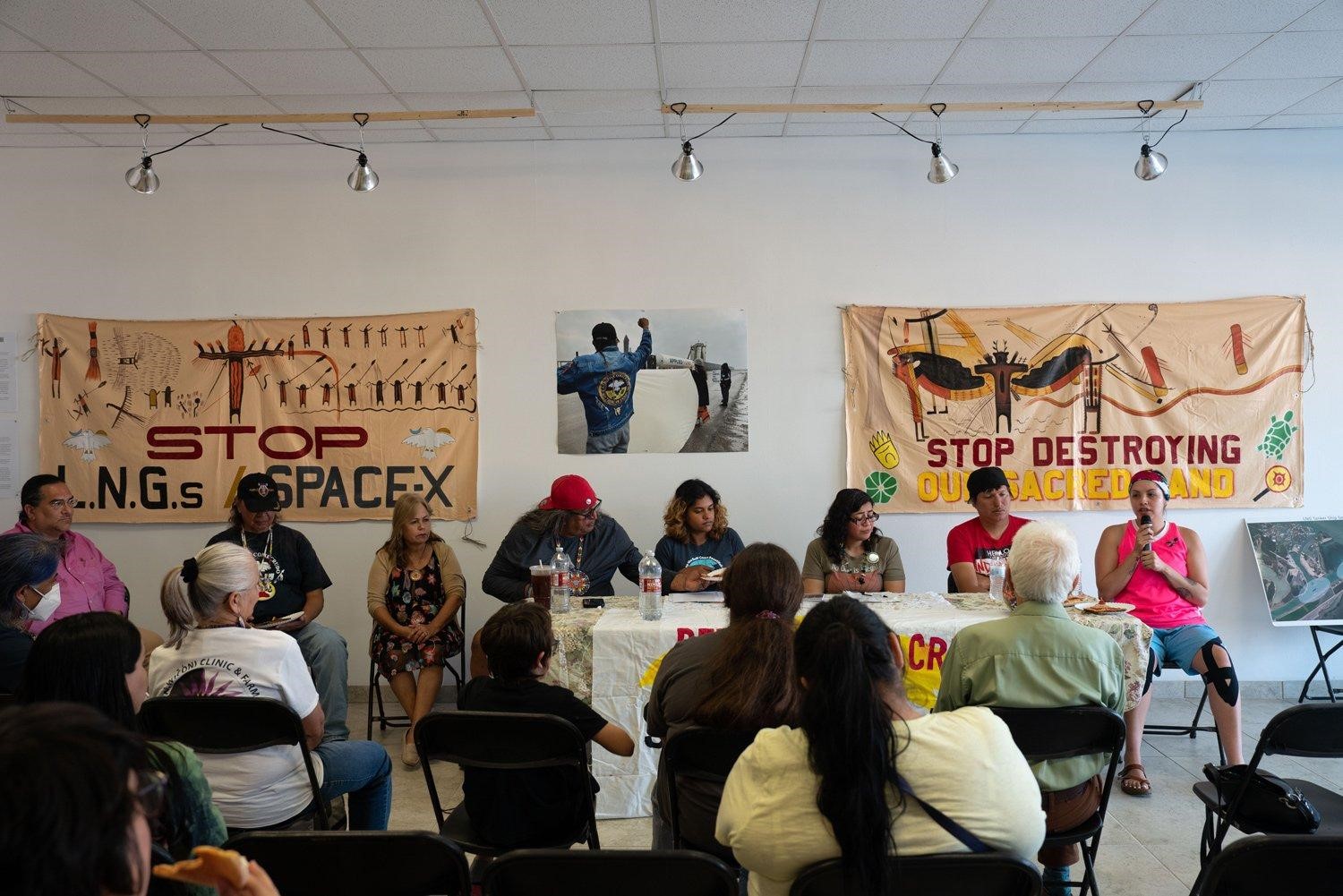When I first set eyes on Táhila in a dark corridor outside DORF I was drawn into her green electric eyes reflecting back to me all the words ever written, all the lies ever told, all the wrongs never righted, and all the sufferings never shared.
Her presence speaks volumes; she is of the Yaqui tribe on her mother’s side (and from her father, another tribe: Jewish) and is the guardian of people’s indigenous and marginalized. Like an eternal flame at a sacred site, her photographic images in this exhibit evoke all the power of ancient truth while reminding us of our present state of ignorance, willful and otherwise.
Without Borders is an important show and statement. Not quite a protest piece, but one analogous to Bob Dylan’s resistance songs of the 1960s. The exhibit runs until May 10, 2025 at DORF.
Tahilia Moss: An Acestral Scribe
Tahilia Moss is more than a photographer; she is an ancestral scribe, an anthropologist of the human spirit, and an artist whose work transcends the boundaries of culture and geography. Her lens does not merely capture images—it reveals the unspoken narratives of people, history, and resilience.
A history of displacement, survival, and cultural fusion steeped Moss’s upbringing Her deep-rooted heritage informs her artistic approach, allowing her to connect profoundly with marginalized communities worldwide. She is not just an observer but an active participant in the stories she tells, forging deep relationships with her subjects and ensuring their voices resonate through her work and in real waking life.
A Journey Through Time and Identity
Moss’s work is a bridge between past and present, intertwining historical memory with contemporary narratives. Through her lens, she illuminates the resilience of diasporic cultures, particularly in regions where identity has been shaped by exile, survival, and rebirth. Her engagement with indigenous tribes is another defining aspect of her career. As a woman of Yaqui heritage, she has spent extensive time living among and working with indigenous communities, from the Amazon rainforest to the remote villages of the Pacific Islands. She has embedded herself within these cultures, participating in their ceremonies, learning their languages, and listening to their histories firsthand.
Her work does not merely document their traditions, but also serves as a platform for their voices. Moss ensures that these communities are not trivialized or made to be exotic. She presents with dignity, agency, and authenticity. She collaborates closely with tribal leaders, elders, and artists, creating visual narratives that highlight their struggles, triumphs, and evolving identities in a rapidly globalizing world.
Moss’s ability to immerse herself in different cultures stems from her own experiences navigating multiple identities. Growing up she was acutely aware of the ways in which cultural heritage could be erased, preserved, or transformed. Her Yaqui heritage connected her to indigenous struggles worldwide, inspiring her commitment to storytelling as a means of cultural preservation.
While she was traveling in eastern Europe where part of her family is from, Poland and Romania.she was chased by skinheads in Prague. She was leaving a rabbi’s office and suddenly those men went after her. She hid somewhere, and became acutely aware what it meant to be an indigenous woman. In Europe, she felt very vulnerable because of her Jewishness.
The Ethics of Representation
One of Moss’s most significant contributions to contemporary photography is her ethical approach to representation. In an industry often criticized for exploitation and voyeurism, she upholds a practice rooted in consent, collaboration, and cultural sensitivity. In the creative process, she lets her subjects determine how their stories are shown.
Her commitment to ethical storytelling extends beyond photography. She has worked on advocacy projects that bring tangible benefits to the communities she photographs, from educational initiatives to cultural preservation programs. She has helped facilitate exhibitions and workshops in indigenous communities, ensuring that the people she photographs also have ownership over how their stories are shared. For Moss, art is not just about aesthetic value but about impact and responsibility.
She founded the organization OJISTA, Sustainable Indigenous Futures offering education outside and building curriculum and supporting teachers
in mainstream schools.
Innovation and Technique
Its fusion of traditional and modern photographic techniques distinguished Moss’s work. She experiments with analog film, alternative printing processes, and digital manipulation to create layered, textured compositions that challenge the boundaries between documentary and fine art. Her images are not mere representations but immersive experiences, drawing viewers into the emotional and cultural landscapes of her subjects.
Her exhibitions are often multi-sensory, incorporating soundscapes, archival materials, and interactive elements to deepen audience engagement. In one of her most notable projects, she juxtaposed contemporary photographs of indigenous ceremonies with historical artifacts and oral histories, creating an experience that transported audiences across time and space. Through these immersive installations, she encourages viewers to not only see but feel the stories she tells.
A Legacy in the Making
Tahilia Moss is not merely documenting history—she is actively shaping it. She is a protector of the natural world and the land. Through her commitment to storytelling, advocacy, and cultural preservation, she challenges the way we perceive identity, belonging, and representation. Her work is a testament to the power of art as a force for connection, understanding, and social change.
Whether capturing the vanishing traditions of indigenous communities, or pushing the boundaries of visual storytelling, Moss continues to redefine the role of the artist in contemporary society. In a world increasingly fragmented by misunderstanding and division, her work serves as a reminder of the enduring power of empathy and the universality of the human experience.
Táhila works with many tribes, including the Misak in Columbia, the Yaqui in Sonora, Mexico (her tribe), and the Guatemala Kiche. People invite her to spaces and gatherings where elders from different nations meet. She’s a scribe of sorts.
Learn about the artist https://www.tahila.net/
Check out the exhibits www.dorfworld.org
